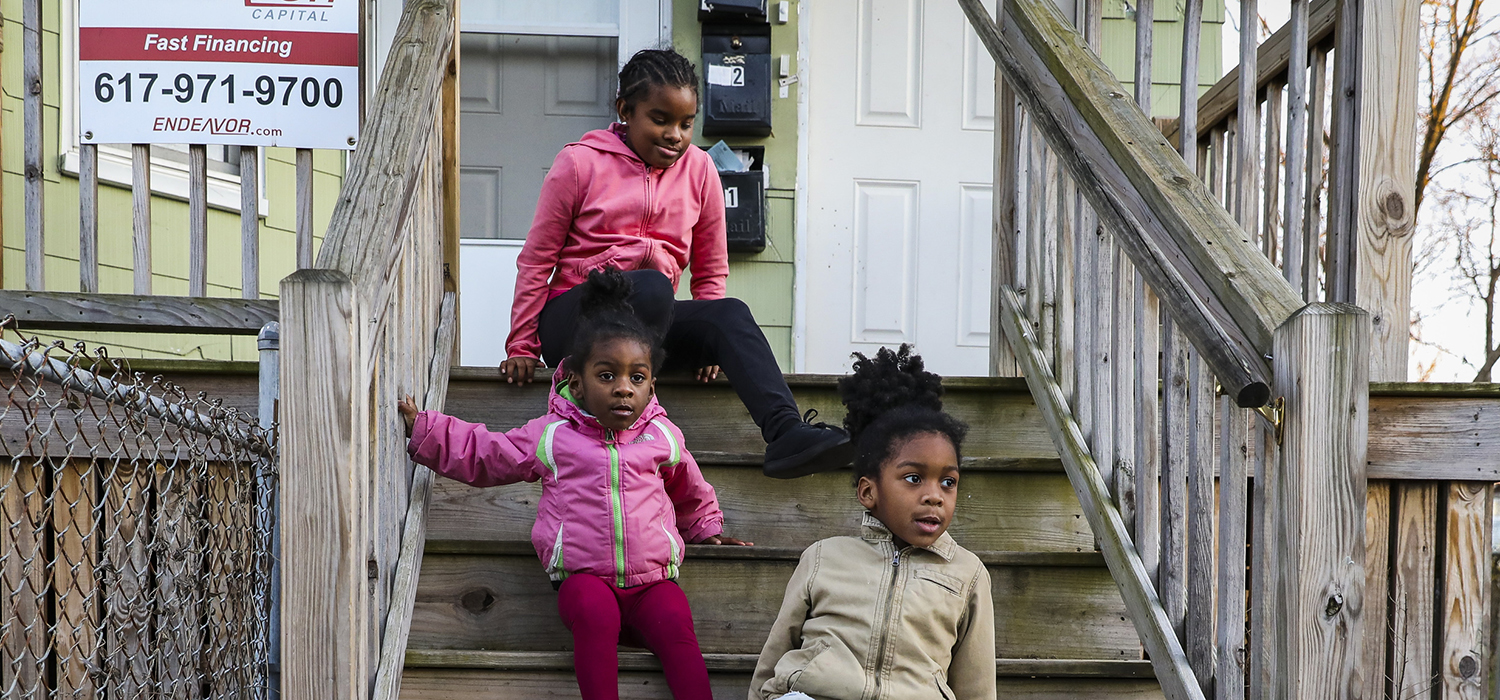
<p>From top down, Dash, 9, sits on the stoop with her friends Malia, 2, Wadiel, 4, and her brother Dish, 1-year-old, in Boston on March 27, 2020. Dash and Dish live with their mom Darling in a shelter apartment in Dorchester while she studies to be a nurse. But recently, Darling lost her job at McDonald's and her food stamps are running out, placing her and her family in a precarious situation during the coronavirus epidemic in Boston. (Photo by Erin Clark for The Boston Globe via Getty Images)</p>
Before the COVID-19 pandemic confined workers to their homes and caused many to lose jobs that provided the income necessary to pay rent, the United States was already facing the worst affordable housing crisis in its history. Overwhelming numbers of families have been competing for a finite and decreasing supply of rental housing, and only one in five low-income families eligible for housing assistance have been receiving it.
This crisis does not bode well for children. As our recently released conceptual model and related materials, Stabilizing Children’s Lives, shows, stable housing is part of an interdependent web of stabilizing supports. Constantly moving homes uproots children’s social networks, disrupts and jeopardizes their learning, and increases the risk of mental and physical health problems. These children may also lack basic necessities, face food insecurity and nutritional deficiencies, and experience unsafe and dangerous conditions. Housing insecurity can also create major challenges for parents working to support their children’s healthy development. High stress levels can contribute to mental health challenges for parents and make it harder to meet their children’s needs.
The public and assisted housing system helps meet the needs of children for stable homes, but it still faces serious hurdles to providing safe, stable, and affordable housing for everyone who needs it. We spoke with Susan Popkin, a fellow in the Metropolitan Housing and Communities Policy Center at Urban Institute, about three ways to engage the safety net to improve children’s access to stable housing.
1. Update the existing system to improve housing access, quality, and security
To guarantee that low-income children have a place to call home, Congress could ensure adequate funding for the Housing Choice Voucher Program, which lifts more than one million children out of poverty each year. A wealth of research suggests housing vouchers reduce homelessness and improve people’s overall well-being by reducing overcrowding and moving children to places with better schooling and more opportunities. Providing a voucher to every family that qualifies for one (akin to recent calls for a universal vouchers) would help stabilize children by allowing low-income families to funnel more of their income toward meeting their children’s needs as opposed to paying rent.
Separately, public housing is critical for stabilizing children in low-income families, yet much of the public housing in the US is old and in need of repairs. The Rental Assistance Demonstration (RAD) program helps housing agencies fund repairs and revitalization, but the program only covers about half the existing housing stock. Fully funding RAD and ensuring that its resident protections are enforced could boost the housing safety net for families with low incomes.
2. Expand the current system to reach and stabilize even more children
The easiest way for the federal government to ease housing cost burden is to provide more subsidies for low-income families. Federal housing subsidies are not an entitlement, and far fewer families receive subsidies than are eligible. A 2015 Urban Institute report suggested that increasing access to housing vouchers to a targeted group of 2.6 million low-income, rent-burdened households with children could reduce child poverty by as much as 21 percent.
Other potential solutions include creating a renter’s tax credit, which two former 2020 presidential candidates proposed in recent legislation. A monthly rent-burden tax credit would allow low-income families to claim a percentage of their rent as a credit with a cap on maximum rent allowable to target low-income renters, similar to the mortgage interest deduction.
3. Stimulate the production of affordable housing
Most new rental construction focuses on high-end apartments, and the supply of low-cost rentals continues to decrease. These changes—in addition to rising rent, increasingly strict government regulations and worsening income inequality—have resulted in both low- and middle-income renters facing significant cost burdens, with nearly three-quarters of the lowest-income renters spending more than half their monthly income on housing. Little of their income is left for meeting children’s other core needs, such as food, child care, and health, leaving these families more susceptible to crises.
To effectively expand the affordable housing supply, local and state governments can increase funding for affordable housing development and reform zoning and land-use regulations to allow for higher-density construction and prioritize policies that preserve the existing housing stock for low-income families and create incentives for property owners to invest in basic maintenance and curb deterioration.
Organizations could also launch public-private partnerships to fund and develop affordable rental housing, much like hospitals and universities have, and the federal government can fully fund the Housing Trust Fund, which provides states with resources to build and preserve affordable rental homes.
The housing safety net helps stabilize millions of American children, but gaps in that safety net, coupled with the affordable housing crisis, mean many children face housing instability that threatens their healthy development. Taking these three steps could help mend the web of stabilizing supports and allow children to thrive.
Let’s build a future where everyone, everywhere has the opportunity and power to thrive
Urban is more determined than ever to partner with changemakers to unlock opportunities that give people across the country a fair shot at reaching their fullest potential. Invest in Urban to power this type of work.